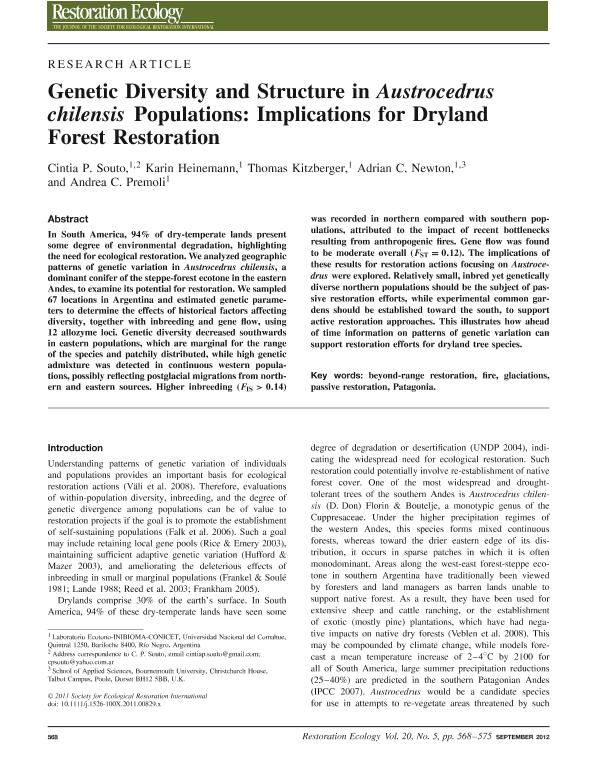Mostrar el registro sencillo del ítem
dc.contributor.author
Souto, Cintia Paola

dc.contributor.author
Heinemann, Karin
dc.contributor.author
Kitzberger, Thomas

dc.contributor.author
Newton, Adrian C.
dc.contributor.author
Premoli Il'grande, Andrea Cecilia

dc.date.available
2019-03-18T17:45:26Z
dc.date.issued
2012-09
dc.identifier.citation
Souto, Cintia Paola; Heinemann, Karin; Kitzberger, Thomas; Newton, Adrian C.; Premoli Il'grande, Andrea Cecilia; Genetic diversity and structure in Austrocedrus chilensis populations:implications for dryland forest restoration; Wiley Blackwell Publishing, Inc; Restoration Ecology; 20; 5; 9-2012; 568-575
dc.identifier.issn
1061-2971
dc.identifier.uri
http://hdl.handle.net/11336/71876
dc.description.abstract
In South America, 94% of dry-temperate lands present some degree of environmental degradation, highlighting the need for ecological restoration. We analyzed geographic patterns of genetic variation in Austrocedrus chilensis, a dominant conifer of the steppe-forest ecotone in the eastern Andes, to examine its potential for restoration. We sampled 67 locations in Argentina and estimated genetic parameters to determine the effects of historical factors affecting diversity, together with inbreeding and gene flow, using 12 allozyme loci. Genetic diversity decreased southwards in eastern populations, which are marginal for the range of the species and patchily distributed, while high genetic admixture was detected in continuous western populations, possibly reflecting postglacial migrations from northern and eastern sources. Higher inbreeding (F IS > 0.14) was recorded in northern compared with southern populations, attributed to the impact of recent bottlenecks resulting from anthropogenic fires. Gene flow was found to be moderate overall (F ST = 0.12). The implications of these results for restoration actions focusing on Austrocedrus were explored. Relatively small, inbred yet genetically diverse northern populations should be the subject of passive restoration efforts, while experimental common gardens should be established toward the south, to support active restoration approaches. This illustrates how ahead of time information on patterns of genetic variation can support restoration efforts for dryland tree species. © 2011 Society for Ecological Restoration International.
dc.format
application/pdf
dc.language.iso
eng
dc.publisher
Wiley Blackwell Publishing, Inc

dc.rights
info:eu-repo/semantics/openAccess
dc.rights.uri
https://creativecommons.org/licenses/by-nc-sa/2.5/ar/
dc.subject
Beyond-Range Restoration
dc.subject
Fire
dc.subject
Glaciations
dc.subject
Passive Restoration
dc.subject
Patagonia
dc.subject.classification
Otras Ciencias Biológicas

dc.subject.classification
Ciencias Biológicas

dc.subject.classification
CIENCIAS NATURALES Y EXACTAS

dc.title
Genetic diversity and structure in Austrocedrus chilensis populations:implications for dryland forest restoration
dc.type
info:eu-repo/semantics/article
dc.type
info:ar-repo/semantics/artículo
dc.type
info:eu-repo/semantics/publishedVersion
dc.date.updated
2019-03-08T16:45:21Z
dc.journal.volume
20
dc.journal.number
5
dc.journal.pagination
568-575
dc.journal.pais
Reino Unido

dc.journal.ciudad
Londres
dc.description.fil
Fil: Souto, Cintia Paola. Consejo Nacional de Investigaciones Científicas y Técnicas. Centro Científico Tecnológico Conicet - Patagonia Norte. Instituto de Investigaciones en Biodiversidad y Medioambiente. Universidad Nacional del Comahue. Centro Regional Universidad Bariloche. Instituto de Investigaciones en Biodiversidad y Medioambiente; Argentina
dc.description.fil
Fil: Heinemann, Karin. Consejo Nacional de Investigaciones Científicas y Técnicas. Centro Científico Tecnológico Conicet - Patagonia Norte. Instituto de Investigaciones en Biodiversidad y Medioambiente. Universidad Nacional del Comahue. Centro Regional Universidad Bariloche. Instituto de Investigaciones en Biodiversidad y Medioambiente; Argentina
dc.description.fil
Fil: Kitzberger, Thomas. Consejo Nacional de Investigaciones Científicas y Técnicas. Centro Científico Tecnológico Conicet - Patagonia Norte. Instituto de Investigaciones en Biodiversidad y Medioambiente. Universidad Nacional del Comahue. Centro Regional Universidad Bariloche. Instituto de Investigaciones en Biodiversidad y Medioambiente; Argentina
dc.description.fil
Fil: Newton, Adrian C.. Consejo Nacional de Investigaciones Científicas y Técnicas. Centro Científico Tecnológico Conicet - Patagonia Norte. Instituto de Investigaciones en Biodiversidad y Medioambiente. Universidad Nacional del Comahue. Centro Regional Universidad Bariloche. Instituto de Investigaciones en Biodiversidad y Medioambiente; Argentina. Bournemouth University; Reino Unido
dc.description.fil
Fil: Premoli Il'grande, Andrea Cecilia. Consejo Nacional de Investigaciones Científicas y Técnicas. Centro Científico Tecnológico Conicet - Patagonia Norte. Instituto de Investigaciones en Biodiversidad y Medioambiente. Universidad Nacional del Comahue. Centro Regional Universidad Bariloche. Instituto de Investigaciones en Biodiversidad y Medioambiente; Argentina
dc.journal.title
Restoration Ecology

dc.relation.alternativeid
info:eu-repo/semantics/altIdentifier/url/https://onlinelibrary.wiley.com/doi/abs/10.1111/j.1526-100X.2011.00829.x
dc.relation.alternativeid
info:eu-repo/semantics/altIdentifier/doi/https://doi.org/10.1111/j.1526-100X.2011.00829.x
Archivos asociados
